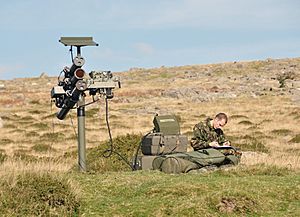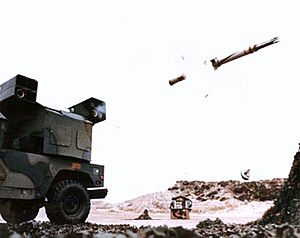Starstreak (missile) facts for kids
Quick facts for kids Starstreak |
|
|---|---|

One of the missiles that Starstreak fires.
|
|
| Place of origin | |
| Service history | |
| In service | 1997 - Present |
| Used by | See Operators |
| Production history | |
| Designed | 1980s |
| Manufacturer | Thales Air Defence |
| Produced | November 1986 |
| No. built | 7,000 |
| Variants | See Variants |
| Specifications (Starstreak High Velocity Missile) | |
| Mass | 16.82 kg (37.1 lb) |
| Length | 1.397 m (4 ft 7 in) |
| Diameter | 13 cm (5.1 in) |
| Crew | 1 |
|
|
|
| Effective firing range | 0.3–7 km (0.19–4.35 mi) |
| Warhead weight | 0.9 kg (2 lb) |
Starstreak is a super-fast British short-range surface-to-air missile. It is also known as a MANPADS, which means it can be carried by a person. This missile is made by Thales Air Defence in Belfast.
Starstreak is also called the Starstreak High Velocity Missile or Starstreak HVM. After it is launched, the missile flies at about Mach 3. This is three times the speed of sound! The British Army has been using Starstreak since 1997.
A soldier can fire Starstreak from their shoulder. It can also be launched from a special armored vehicle called the Stormer. Starstreak can hit targets from about 300 metres away up to 7,000 meters away.
Contents
How Starstreak Was Developed
Starstreak began to be designed in the early 1980s. The British Ministry of Defence wanted a new weapon. This weapon would work alongside the Rapier missile system.
In 1984, two companies, British Aerospace and Shorts Missile Systems, were asked to create their ideas for the missile. Shorts Missile Systems won the competition. They were given money to develop the weapon further. Starstreak officially started being used in September 1997. It was meant to take the place of the Javelin surface-to-air missile in the British Army.
New Versions of Starstreak
In 2007, Thales UK announced an improved version called Starstreak II. This new version could fly even farther, up to 7 km. It also had a better system for finding targets. It could even find aircraft that were flying very high.
Later, in 2011, Thales decided to focus its money on another missile. This meant less money for Starstreak development.
How Starstreak Works
The Starstreak missile is kept inside a sealed tube. This tube is attached to the main firing part of the system. The person firing the missile, called the gunner, uses a special aiming system to follow the target. Once the target is lined up, the gunner presses a button to launch the missile.
First, a small motor fires to push the missile out of its tube. This motor stops burning before the missile fully leaves the tube. This keeps the gunner safe. Once the missile is away from the gunner, a second, more powerful motor fires. This motor makes the missile speed up to Mach 3.5. It stops burning when the missile is about 400 meters away.
The back of the missile has systems that guide it using laser beams sent from the launcher. The Starstreak missile does not hit the target as one big piece. Instead, it launches many small "darts" at its target. Each dart has about 450 g (16 oz) of explosive inside it.
When these darts hit the target, a special device called a fuze is triggered. This fuze causes a small delay before the explosion. This delay allows the darts to get inside the target before they blow up. The explosive is surrounded by a shell of tungsten. This tungsten is designed to break into many pieces. This causes as much damage as possible inside the target.
In 1999, Starstreak was shown attacking an armoured personnel carrier. This proved that it could also be used to attack targets on the ground, not just in the air.
In 2012, during the London Olympics, the Ministry of Defence placed Starstreak missiles on top of an apartment building in London. This was done for security reasons. Some people living there were not happy about it.
Different Kinds of Starstreak
- ATASK (Air To Air Starstreak): This version is designed to be fired from a helicopter, like the AH-64 Apache. It has not been used in service yet.
- LML (Lightweight Multiple Launcher): This type of Starstreak has three missiles ready to fire at once. It can be put on vehicles like a Land Rover or a HMMWV (Humvee).
- SP HVM (Self-Propelled High Velocity Missile): This version is carried on an Alvis Stormer vehicle. It has a launcher on the roof with eight missiles ready to fire. Another 12 missiles are stored inside the vehicle.
- THOR/Multi Mission System (MMS): This is a system with four missiles on a special turret. It is placed on a Pinzgauer vehicle. Thales UK announced this in 2005.
How Starstreak Performs
Good Things About Starstreak
- It is very hard to "jam" or block its signals.
- It cannot be destroyed by anti-radar missiles.
- It travels at a very high speed. This makes it more likely to hit fast-moving aircraft.
Challenges with Starstreak
- The small darts need to hit the target directly to cause damage.
- Things like smoke can make it hard for the gunner to see the target. This can also affect the missile's guidance system.
- The skill of the gunner is very important. The gunner needs to follow the target exactly with Starstreak's sight for the missile to work well.
Who Uses Starstreak

- Britain: The UK uses the SP HVM version. They have about 150 Starstreak systems.
- South Africa: South Africa uses the LML version. They have about 120 Starstreak systems.
Images for kids
-
Alvis Stormer (HVM SP) firing Starstreak in 2014
See also
 In Spanish: Starstreak para niños
In Spanish: Starstreak para niños






